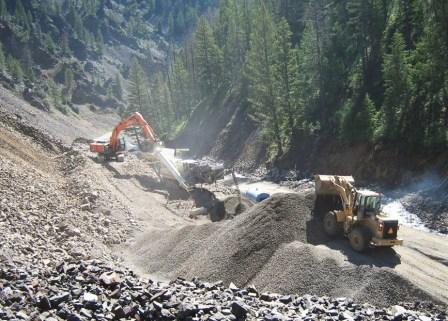
2011 has been a coming out party for rare earth elements and, more recently, a broader category of strategic raw materials.
Strategic minerals constitute a variety of minerals and elements, most of which are minor metals, that are deemed critical to certain supply chains. Many minor metals are consumed in relatively small quantities, when compared to the likes of iron and copper, and they are often produced by just a few suppliers in limited geographical areas.
Rare earth elements, for example, are considered strategic by almost every country in the world with the exception of China. The Chinese control approximately 97% of current global production. For the related article entitled, “Rare Earths under Chinese Control” – CLICK HERE.
The U.S. Geological Survey reported in its “Mineral Commodity Summaries 2011” that in 2010 the U.S. imported more than 50 percent of its consumption of 43 minerals and 100 percent of 18 minerals. This is the continuation of a 30-year trend of growing reliance by the United States on foreign sources of these commodities. Of late, this issue has been gaining significant political attention in the U.S. culminating in the House Natural Resources Committee’s unanimously approval of the “National Strategic and Critical Minerals Policy Act of 2011.”
Although three of the technology metals (tellurium, indium and selenium) often make critical mineral lists around the world there are, somewhat surprisingly, no primary mines for these raw materials. Instead, they are extracted in small amounts as byproducts from the mining of gold, copper or zinc. Tellurium, for example, is a technology metal critical in solar power applications. And despite being as rare as gold, it is relatively cheap because it falls out during the refining of copper, explains Robert Jaffe, professor of physics at Massachusetts Institute of Technology (MIT). Gallium, another element used in solar energy, is also a co-product of copper mining. The annual global production of gallium is estimated at just 78 tonnes. Historically, co-production has kept the price of many of these scarce elements quite low.
Weeding through the long list of critical minerals we found a few interesting ones. Connecting these minerals with Canadian listed mining companies resulted in this month’s feature article, “5 Strategic Mineral Stocks to Watch” which we present in no particular order.
1. North American Palladium Ltd. (TSX: PDL)
In 2001, fearing that palladium supply could be cut off at any time from Russia, Ford began stockpiling palladium. This decision helped drive the price up to over $1,100 per ounce. By 2002, Ford’s stockpile was so large that it represented 38 percent of the total U.S. imports of the metal in a good year. Then the price dropped by 75% and Ford ultimately reported losing $1 billion on their holdings.
What’s interesting is that automobile manufacturers like Ford aren’t necessarily dependent on palladium in order to manufacture catalytic converters. Other metals can be substituted, namely platinum and rhodium. And, in 2001 during their stockpiling foray, Ford actually produced catalytic converters with no palladium.
But collectively, the platinum group metals (PGMs) are a strategic resource as they have excellent catalytic properties. Other distinctive properties include resistance to chemical attack, excellent high-temperature characteristics, and stable electrical properties. All these properties have been exploited for industrial applications and, not to mention, platinum (and to a lesser extent palladium) are also used in jewelry manufacturing.
With China now emerging as a major force in automobile manufacturing some think that palladium could be a good place to park your money. Analysts from Barclay’s Capital are of the opinion that palladium demand continues to be supported by China’s bias towards gasoline-powered vehicles and the growing preference towards larger vehicles; plus, another wave of emission standards scheduled to be implemented this year. The spot price for palladium is currently $824 per ounce.
One TSX listed company hopes to benefit from palladium’s strong comeback from lows of just under $200 per ounce in early 2009. North American Palladium’s Lac Des Iles mine in northern Ontario is one of only two primary palladium mines in the world. Palladium is typically mined as a byproduct often found with gold in Russia, PGM complexes in South Africa and within nickle/copper deposits North America. Despite the strong price performance of palladium some analysts are not bullish on the company’s stock, equities research analysts at Stifel Nicolaus downgraded shares of North American Palladium to a “Hold” rating in a research note released earlier this year. Since the downgrade on April 11th, the company’s shares have fallen from $6.28 to $4.04 today.
In addition to palladium the company also has a focus on another precious metal, namely gold. On May 26, 2009, the company acquired the Sleeping Giant gold mine in the Abitibi region of Quebec through the acquisition of Cadiscor Resources and continues to develop that project.

2. Formation Metals Inc. (TSX: FCO)
Cobalt is classified as a strategic metal by the United States Government and a critical metal by the European Union. Highly purified cobalt, a technology metal, has applications in the aerospace industry because it is very resistant to corrosion and damage, even at high temperature. It is also used in the manufacturing of rechargeable batteries and in medicine.
Although cobalt’s use is varied, only about 77,000 tonnes of refined cobalt was produced globally in 2010. With cobalt trading on the London Metals Exchange for $35,000 per tonne, this represents an estimated market value of US$2.7 billion. The main source of the element is as a by-product of copper and nickel mining. The copper belt that runs across the Democratic Republic of the Congo and the Republic of Zambia yields most of the cobalt mined worldwide. But one company is looking to break tradition.
Formation Metals is well on their way to becoming North America’s next cobalt producer having raised over $170 million in equity financing. Based on a NI 43-101 technical report released by the company in 2007, the Idaho cobalt project’s projected output will be equivalent to 3.3% of global cobalt supply which translates into 14.9% of North American’s annual demand. With ongoing political issues in the Congo which have, since 1998, chronically threatened to disrupt global cobalt supply, Cobalt’s recent status as a strategic metal and proximity to local markets in the U.S., some think Formation Metals is a good bet.
Jennings Capital analyst, Ken Chernin, issued a speculative buy recommendation on May 26th, 2011 with a 12 month target of $2.60, more than double today’s current price of $1.24. Chernin sites low costs of production, few impurities, the mine’s U.S. location and the company’s hydrometallurgical facility as reasons for his recommendation.
MiningFeeds.com recently connected with the President & CEO of Formation Metals, Mari-Ann Green, to find out more about cobalt and the company’s progress in Idaho – CLICK HERE – for the exclusive interview.
For 5 Strategic Mineral Stocks to Watch – Part 2 – CLICK HERE.



 Follow us on Twitter
Follow us on Twitter Become our facebook fan
Become our facebook fan










Comments are closed.